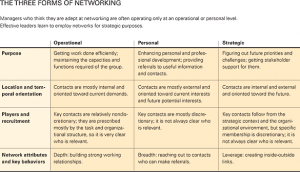LeaderShift – Action Advantage tip: 1 Minute Wisdom for smarter Leadership:
networking—creating a stronger fabric of personal relationships/contacts who care enough to provide support, feedback, insight, resources, and information—is one of the most self-evident and one of the most often avoided developmental challenges that new leaders must handle.
Most managers don’t realize… they need to move beyond their functional expertise and specialties and address strategic higher level issues facing the business.
Many managers do not understand the importance of relationships vs technician – that their leadership role involves more relational— and less technical analytical tasks.
seldom do they comprehend that interactions and exchanges with a wide array of prevailing/ current and potential stakeholders are not problems-to-be-avoided, but areactually an important aspect of their “real work”. Its actually at the heart of their new leadership roles.
3 types of Leadership Networking
3 distinct and interdependent modes of networking are prominent in successful leaders.
- Operational
- Personal
- Strategic
These approaches to business workplace networking played a vital role in their development and growth in their leadership roles.
The first Operational Networking helped them manage pressing and current internal responsibilities,
Personal Networking, the second boosted their personal development, social support system,
The third, Strategic Networking, opened their eyes and minds to new business opportunities, challenges, directions and the stakeholders they would need to connect with and enlist.
Operational Networking
All managers need to good working relationships who can help them get the desired business results. Many operational networks include
- direct reports and superiors
- peers within operational units
- internal “power” players who can stop/block or support projects/actions
- key outsiders such as suppliers, distributors,
- customers.
The purpose of Operational networking is to team build, connect, ensure coordination and cooperation among people/teams who have to know and trust one another in order to accomplish their immediate tasks more effectively.
That is simple, because the task provides a focus and clear criteria for network/team membership: Either you’re necessary to the job/project and supporting results, or you’re not.
Many Manager-leaders have blind spots regarding their networks: people and groups they need to ensure things happen.
One of the biggest challenges with only focusing on your problems with an sole reliance on operational networks is that they are geared toward meeting operational day to day objectives, and not toward asking the big strategic questions like , “What should we be doing to build sustainability or competitiveness and effectiveness?”
Largely the “right” operational relationships are directed by the job/role and organizational structure. So, most operational networking occurs within an organization, and links are determined in large part by daily routine, short-term operational demands.
Of course, an individual manager can choose to deepen and develop their links and networks.
The quality of relationships: —the rapport and mutual trust gives an operational network its power and cohesion. The organizational structure/ constraints on network membership controls these connections which means many are unlikely to deliver power or value beyond assistance with the task or project at hand.